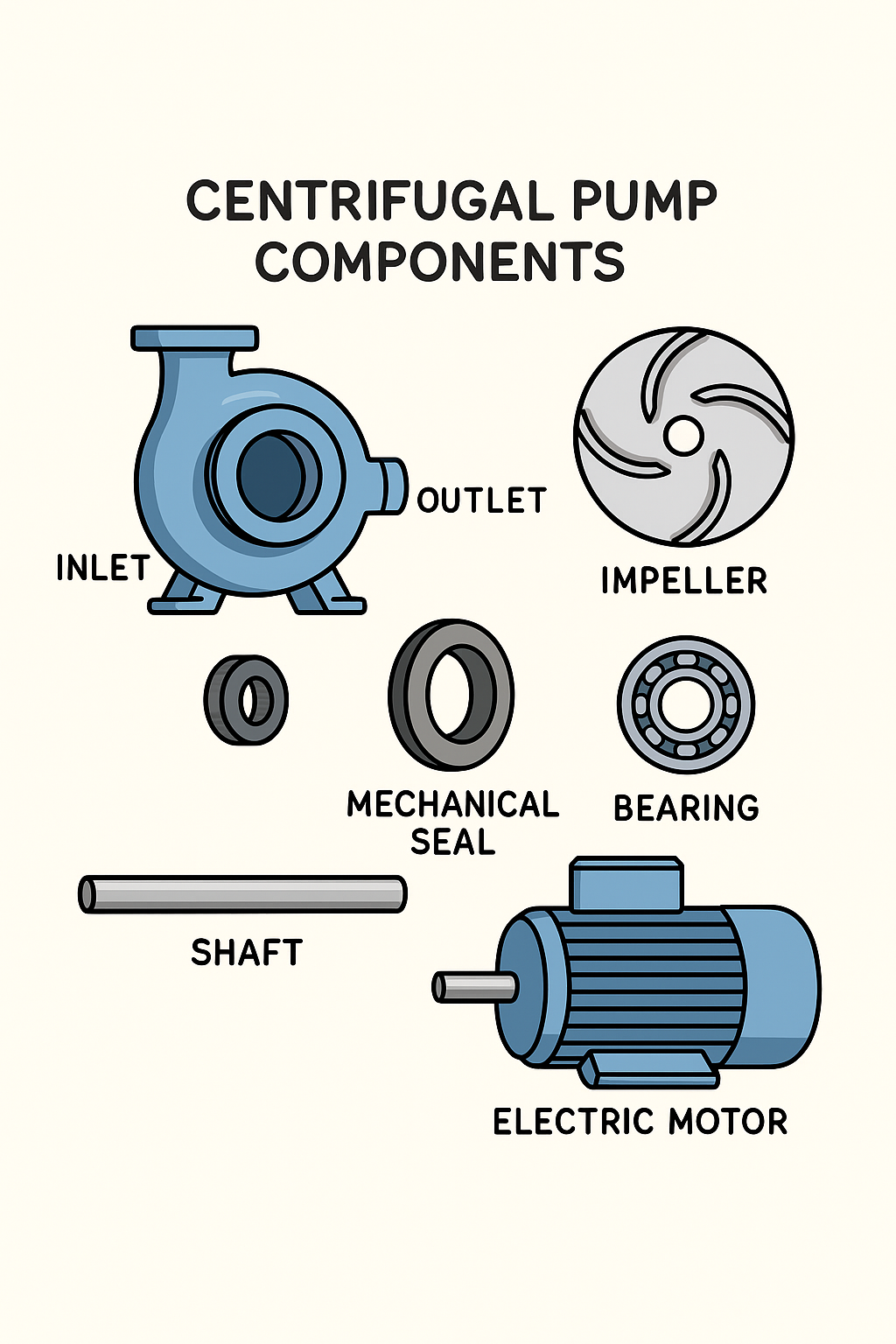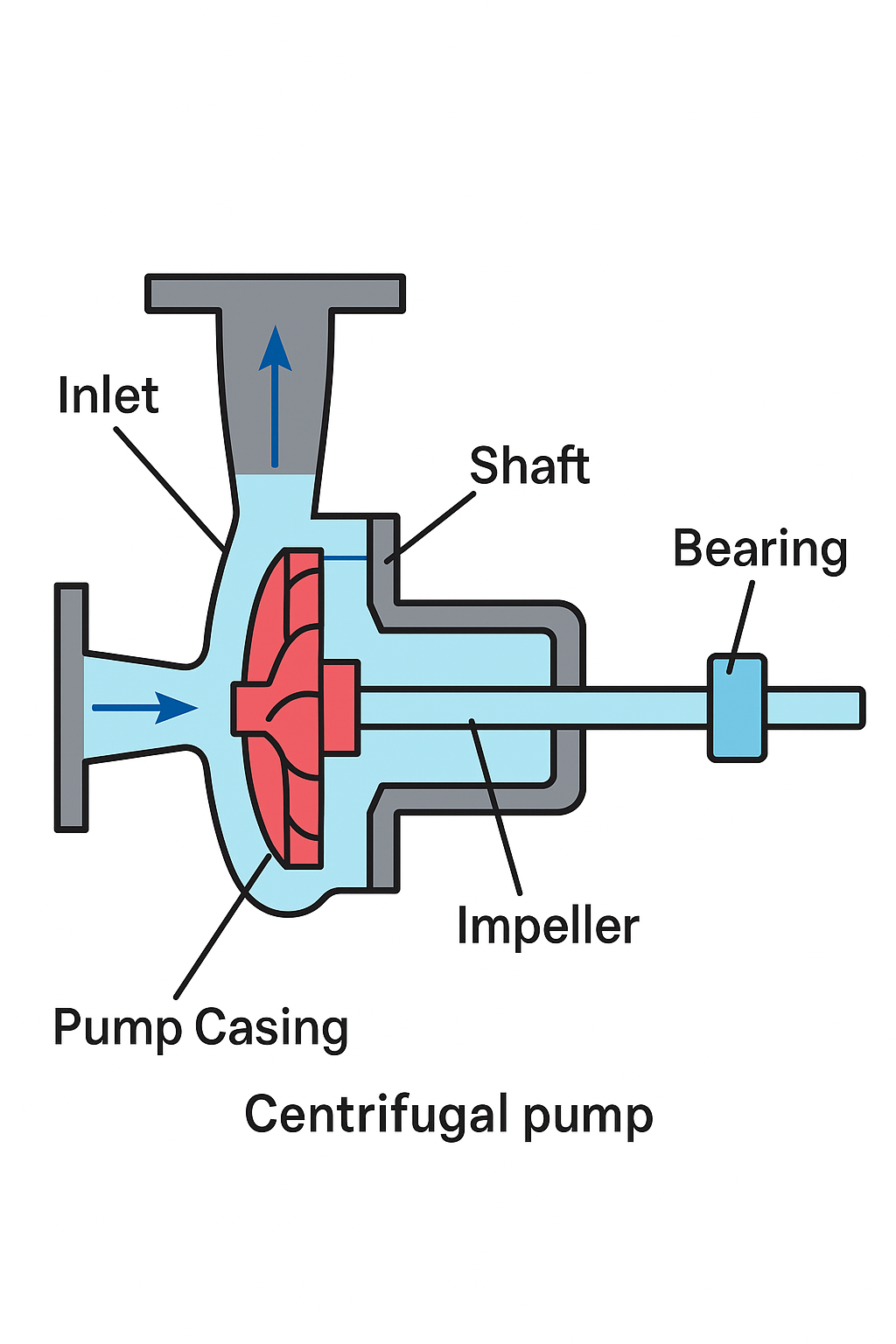Centrifugal pumps are the most widely used type of pump in industries, water treatment, agriculture, and domestic settings. Their simplicity, efficiency, and versatility make them suitable for handling a variety of fluids, including water, chemicals, slurries, and hydrocarbons. To understand how a centrifugal pump works and why it’s so widely adopted, it’s essential to examine its major components and their functions.

1). Introduction to Centrifugal Pumps:
Centrifugal pumps work on the principle of centrifugal force, which is generated by a rotating impeller. Fluid enters the pump impeller along or near to the rotating axis and is accelerated by the impeller, flowing radially outward into a diffuser or volute chamber, from where it exits the pump.
The efficiency and reliability of a centrifugal pump depend heavily on the proper functioning and design of its components. Let’s explore each part in detail.
2). Major Parts of a Centrifugal Pump:

a). Impeller:
Function:
The impeller is the heart of a centrifugal pump. It is a rotating component that imparts kinetic energy to the fluid. The impeller blades push the fluid outward from the center (eye) to the outer circumference, increasing its velocity and pressure.
Types of Impellers:
- Open Impeller: No sidewalls; easy to clean but less durable.
- Semi-Open Impeller: One side wall; handles solids better.
- Closed Impeller: Two side walls; high efficiency, used for clean fluids.
b). Casing:
Function:
The casing surrounds the impeller and captures the velocity of the fluid, converting it into pressure as the fluid exits the impeller. It also directs the fluid to the pump outlet.
Types of Casings:
- Volute Casing: Spiral-shaped to reduce velocity and increase pressure.
- Diffuser Casing: Consists of stationary vanes around the impeller to further guide and decelerate fluid.
c). Shaft:
Function:
The shaft transmits mechanical energy from the motor to the impeller. It must be precisely balanced and strong enough to resist bending and torsional stress.
d). Shaft Sleeve:
Function:
A protective sleeve fitted over the shaft to guard against wear, especially in the sealing area. It can be replaced when worn, extending the shaft’s life.
e). Mechanical Seal / Gland Packing:
Function:
Prevents leakage of the pumped fluid along the shaft.
- Mechanical Seals: More efficient, less maintenance.
- Gland Packing: Lower cost, more suitable for older designs or where some leakage is acceptable.
f). Bearings:
Function:
Support the shaft and maintain alignment during rotation. They reduce friction between moving parts and can be either ball bearings or roller bearings.
Lubrication: Bearings require regular lubrication to prevent overheating and wear.
g). Wear Rings:
Function:
Provide a replaceable, low-cost wear surface between the impeller and the casing. They help maintain close clearances and prevent internal recirculation of fluid, which improves efficiency.
h). Suction and Discharge Nozzles:
Function:
- Suction Nozzle: Entry point of the fluid into the pump.
- Discharge Nozzle: Outlet through which the fluid exits at high pressure.
Correct alignment and sizing of these nozzles are critical for smooth operation and preventing cavitation.
i). Baseplate and Coupling:
Function:
- Baseplate: Provides structural support and alignment for the pump and motor.
- Coupling: Connects the motor shaft and pump shaft, transmitting power while accommodating minor misalignments.
Diagram & Working principle of centrifugal pump:

1). Fluid Entry (Suction):
- Fluid enters the pump through the suction nozzle and flows into the eye (center) of the impeller.
2). Rotation of Impeller:
- The impeller, which is connected to a motor-driven shaft, begins to rotate at high speed. As it spins, it imparts kinetic energy to the fluid due to the centrifugal force.
3). Energy Conversion (Kinetic to Pressure):
- As the fluid is pushed outward through the impeller vanes, its velocity increases. When the fluid exits the impeller, it enters the volute casing or diffuser, where the velocity is converted into pressure energy.
4). Fluid Discharge:
- The pressurized fluid is then directed through the discharge nozzle and into the desired piping system or application area.
Key Principle:
The centrifugal pump uses the centrifugal force generated by a rotating impeller to move fluid outward from the center and increase its velocity and pressure.
Important Points:
- The pump must be primed (filled with liquid) before starting to avoid dry running.
- It delivers continuous, smooth flow.
- The head (pressure) developed is directly related to the impeller speed and diameter.
Benefits of Centrifugal Pumps:
- Simple and robust construction.
- Wide range of capacity and head.
- Low operating and maintenance costs.
- Smooth and non-pulsating flow.
- Adaptable to a variety of fluids and systems.
Limitations to Consider:
While centrifugal pumps are versatile, they do have some limitations:
- Not ideal for highly viscous fluids.
- Performance is sensitive to changes in system head.
- Can suffer from cavitation if suction conditions are poor.
- Not self-priming (unless specifically designed).
Conclusion:
Centrifugal pumps are essential in modern fluid transfer systems due to their reliability, efficiency, and adaptability. Regular maintenance, proper material selection, and correct pump sizing are key to extending the life and efficiency of centrifugal pumps in any industry.